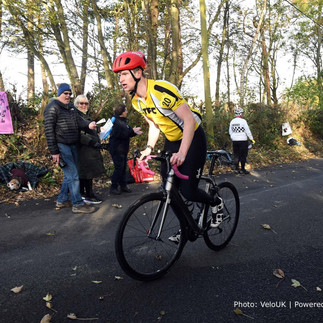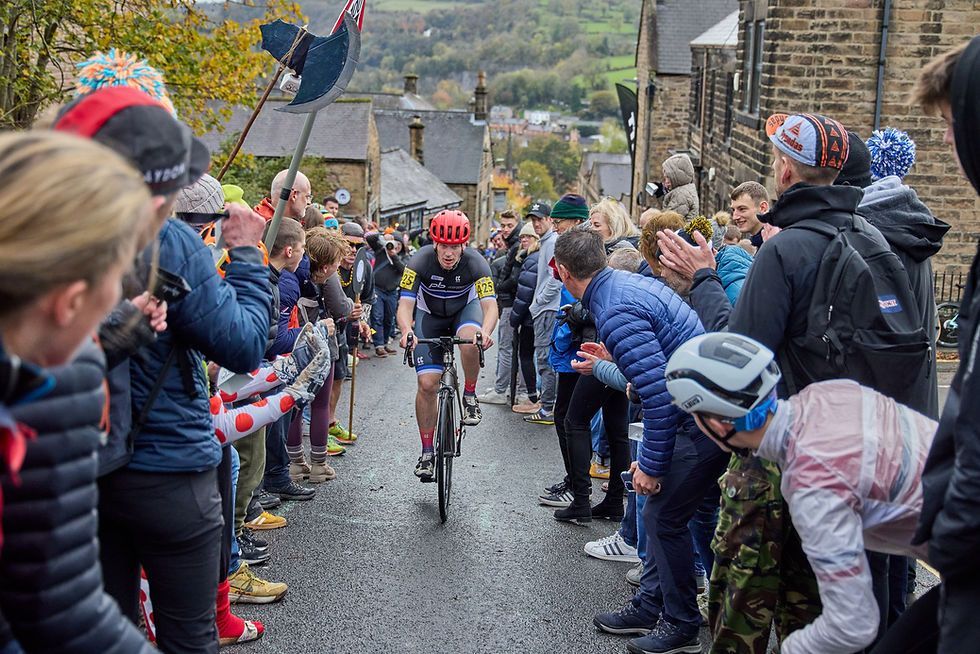Paracycling | Hill Climb Szn!
- Zac Rogers
- Nov 3, 2024
- 9 min read
Hill Climb Szn! My first season I’ve properly taken part in and one that I will always try to focus on in the future. From a high level perspective, it’s very similar to track efforts and, therefore, aligns with the rest of my winter focus - and the other side of it, I love these type of efforts. (Side note: The community is probably the best in cycling). Due to the Paracycling National Series and other commitments, I decided to only enter 2 races which were Sudbury CC (Watson’s Hill) and the National Championships!
As Autumn hit, I moved to a more track based programme, which included finishing up my accreditation (Stage 4) and having a go on the back of a tandem. The tandem is good fun; it’s like a weird turbo session where you can’t really see, and you just have to go all out. Probably one of the funniest days I’ve had on the bike (including my little moment falling off when we stopped for the first time). It took some getting use to, but we won the 200m flying heats (which shouldn’t be unexpected given both I and the pilot race). It was, also, so ungeared, but everyone had the same issue.
This was followed by the next day doing my first Hill Climb race of the year, which was the Sudbury CC Hill Climb up Watson’s Hill - #124 on the Top 100 Climbs in the UK with a 1/10 rating for it’s 400m at 9% and 11% max. I didn’t do any changes to the bike so had a 52/34 on the front and a 11x28 on the back (or in other words meant that I only had four gears for the race).
The plan was to do around 700w but I struggled with the gearing and probably could have gone a quicker if I had swapped the rear cassette from 11x28 to 11x34 (which I did post race). This is as I forced myself to go into a lower cadence than I would like, with the 66second effort averaging 75rpm.
The other thing that didn’t help was my failure to clip in. The timed effort was around 73seconds but the actual power effort was around 66seconds at just over 600w.
There were a few lessons to take away from my first hill climb of the year which included being comfortable being held at the start.
While I might sound a bit annoyed about my effort, it was still a new 1minute power best (619w/636w NP) and the first 30seconds were at target pace (690w) among with the steepest gradient. I think I was probably too optimistic given I was on the track the day before and with the small crash.

I followed this up with an endurance ride, which was probably a step too far, with the combination of a track session and the Hill Climb meant that my ankle was struggling. That said, the effort was just over 80minutes at 225w average (251w NP), which felt comfortable outside of the ankle hurting. After the 6th attempt of Watson’s Hill (3 recce times, 1 race, 2 endurance ride), I decided enough was enough and pulled the pin.

The following week I got a 48hour bug but thought I was good to go for the weekend - I was not. I joined the Peterborough CycleHub ride and the first hour was brutal - but I knew the power wasn’t high (at around 290w NP). I decided to cut it short and cruised in the final hour. I also started wearing a heart rate monitor but need to wear it more often to judge where the heart rate should be for each effort.

The following day was the final British Paracycling Dev Road Day (#6), in which I had planned for 2 hours of technical work (normally corners and sprints) followed by an hour long social ride with a few others. It turned into 2 hours of technical work, 90mins of chaingang work before finishing off the coaching session with a 10km TT. The sprints weren’t optimal, but they weren’t expected to be either. That said I hit 1000w, which is always a good sign - with the screenshot below showcasing my top six 2 second efforts. The cadence is interesting as it’s all over 100rpm which I guess makes sense considering it was a cornering drill - while the majority of my best power numbers for sprinting tend to come from around 80-85rpm.

I’m not going to pretend that I wasn’t close to dead before the 10km TT, but I thought I did really well to hold 305w for the 16minutes (0.95 IF given the 320w FTP). Obviously it's not the perfect split, but I think that the screenshot below which split the 16minute minute effort into 5 minutes demonstrates how consistent I was. Slightly higher numbers to start to 1) Get to the pace I wanted to set 2) See how the legs felt. Then I set a pace I knew I could do and was confident in before increasing the pace to the max effort I could do to finish off. I could have probably extended it to 20minutes, but that would have been a real push.

This was followed by a busy weekend which involved being in Manchester for a conference and then going to Derby on Saturday for Derby’s Paracycling open session. The idea was that my bike could have arrived but it didn’t. That said it was a good session of working with the tandems in a pace line and following Millie on her efforts. Which while I had put in an effort showed me how much being aero actually makes a difference along with gearing.
The following day was meant to be a long endurance session, but a combo of a busy few days and the cold weather, I decided to call it after an hour. The session turned into an aero practice session where I held the most aerodynamic position as long as I could - that was for around 23 minutes! The legs just weren’t there either. This was when I started to suspect that I underestimate the impact of track cycling on my ankle, likely related to the fixed gearing where you are forced to pedal in a circle while my pedal stroke on the road is very much up-down-up-down.

The following week was the big week in that my track bike arrived, I got it fitted properly and I did my first big session on the track bike!

Unfortunately, while the power meter was on the bike, I didn’t have time to set it up, so there was no data. The session was split into four: Warm Up/Track Acclimatisation (which I used to make sure the bike was properly set up), some technical group work and then we did some out of the saddle work followed by 250m efforts out of the gate. Due to gearing, this was the first time I properly went out of the saddle on the track. The start gate was actually a lot easier than I thought. The biggest thing is learning timing, as I found out on the 2nd attempt where I went too early and clipped out as a result.
While equipment means so much on the track and that my bike still needs to have some upgrades (tyres, wheels, pursuit bars being in the main three), I think I suit the track the most at the moment. That said, I still have a long way to go in learning about how track actually works and a lot of training to go ahead of the National Champs in Manchester (end of February).
I also got my Wahoo Kickr Rollrs during the week and did a few rides to make sure everything worked as it should - you have to do 3x 10minute efforts to be able to race on Zwift now. So, two of them were easy, but I thought I’d do one fairly hard to see what I could do on tired legs. The 12minute effort was at 292w average (305w NP), which wasn’t too bad for my first indoor effort. The effort which was done without fans or anything was a mistake but a good learning curve to remind myself how hot Zwift racing can get.

The following day, I joined my first Zwift race (KISS 100) with the intention of doing about 90mins of the race. I learnt my lesson of track day = ankle pain, so I never committed to doing the whole 100km. In the end, I did just under 70mins and then stopped due to the pain. The biggest thing for me was how it highlighted my need to improve continuous 30second sprints as I survived three big efforts, but the fourth was too much. Perhaps something interesting to note is that if it was a different course (Reverse Richmond 2015 World Champs), I could have been able to keep up as the average power wasn’t that high for the winner (3.5w/kg for 2hours20mins).

I have a few big objectives for the winter that I have set out and two of them are worked on through being on the track bike - ankle strengthening and aero position. As a result, I’m going to be doing endurance sessions on the track bike over winter. From an ankle perspective, the pedal motion will strengthen it anyway but the other big gain is that the efforts are low cadence (around 70-75rpm). This is just a combination of the gearing (96) and minimum resistance, but it is a perfect match for what I was looking for. The second objective is the aero position; just by being on the track bike, I’m getting used to being more aero. There is a long way to go in terms of being as aero as I can on the track bike, but it’s a start.

And now onto the end of block race! Which is the Hill Climb National Championships and a trip back to Newcastle. Obviously, I was looking forward to it, but I didn't have the same drive that I do from other races. I think that probably is related to how much I’m enjoying the track and how my focus switched to building up for February and therefore I didn't do any 5minute effort training.
That all said, I did a recce the day before which was a key part of understanding the climb. I went into the weekend thinking around 5minutes at 400w. In theory, according to WKO5 with different models showing a range between 380w and 420w (side note: I’ve not done a pure 5minute effort so the models won’t be perfect). The idea around 400w is that if I can do more, then I can attack the end as it steepens and if I can’t, then I just die as everyone else does and hope the wall of noise carries me.
The target above was done before I had done a recce, and my suspicions were confirmed. I did two efforts which were done at around 300w but with two different strategies. The first was a consistent effort while the second was easy start, semi-hard finish. This was designed to see how much of an impact a negative split would have. The big thing was that I needed to ensure that I could attack the first bump while having capacity to attack the final section.
This confirmed that my time would be around 5minutes as I thought before the recce, but I didn’t really have any expectations.
You can, also, see that I spent much more time chatting (about the effort among other things) as I did riding. But the purpose was to do two efforts including one semi-hard and I did that.

And then Race Day! The nerves were there, but the atmosphere was amazing. The first 90 seconds was weird, I was trying to go as slow as I could but I went out at 450w - that was a mistake. The crowd and the buzz got to me. The negative split attempt was done for, but it wasn’t too bad that I still felt in control. The next minute was just over target power (405w) before the first ramp which was 35seconds at 435w. I, then, followed the plan of brief “recovery” of 380w for a minute before ramping up to 400w for the start of the final section. This is where I think I messed up slightly again; I intended to recover on the flat section but went too low, almost 10 seconds at 320w, which meant that I could do around 440w for the final steep section where I overtook someone before dying at 350w from the steep section to the finish line.
When aggregated it was a time of 5minutes 5seconds where I did around 409w average (413w NP). I smashed the target power, even with all the mistakes I mentioned, and was very close to my target time - on the plus side, I don’t have to do a 5minute test for a while (which I would have had to do if I went sub 5mins)! That said, I think 420w is more realistically the power I can do if it was a consistent effort.
The thing I’ve not mentioned yet is the start which was a bit of a mare, but still much better than Sudbury CC. I decided to go for the barrier hold approach rather than being held and I pulled a bit too hard that I didn’t get the resistance I wanted so I had to push off again.
Overall, I think I could have gone sub 5minutes if I stuck to my original plan and had a good start. But I’m delighted with the effort and looking forward to next year’s already. Obviously a lot of this depends on the race calendar for the road, but I’d like to do a few more next year as prep for the track season ahead.

Also some pics thanks to UnsponsoredMedia, Bob McGregor, VeloUK and Brian Bolt.
Which goes onto the next block which will be final prep (3 weeks) ahead of Para Scratch Nat Champs which are on the 16th November. Essentially, I’ll be on the track as much as I can until then (and also after then).
As always I wrap up with my FTP which tbh is completely unknown, I know it’s at least 320w but I’ve not done a proper FTP effort in a while. My weight is still stable and was 79.3kg before the Hill Climb meaning that my FTP is at least 4.04w/kg.

















Comments